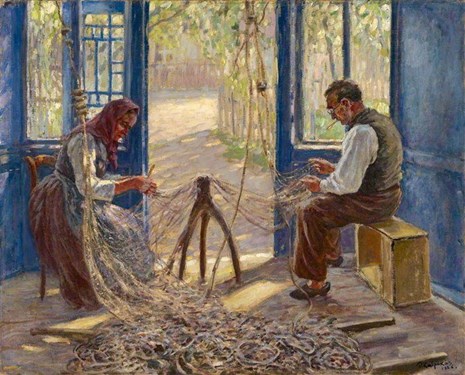Petras Kalpokas. Peaceful life. 1926
Oil on canvas, 60x74.
Vilnius was the main centre of Lithuanian artistic life at the beginning of the 20th Century. Then it was a city of the Russian Empire, and the centre of the region. Artists who studied at schools in Warsaw, Krakow, St. Petersburg, Paris and Munich lived and worked here; art societies were founded and exhibitions were organised. Aartists who studied at the Vilnius Drawing School and later became famous include Jacques Lipchitz, Chaim Soutine, Lazar Segal, Michel Kikoine. The artists who lived in Vilnius were mostly Russian, Polish and Jewish. The Lithuanian art movement was stimulated by The Lithuanian Art Society, which organised exhibitions of Lithuanian art from 1907. Various tendencies, such as realism, impressionism, symbolism, modernism, can be seen in works by Vilnius artists.
The art in Vilnius from this period is strongly represented in the collection of the Lithuanian Art Museum, which is in possession of works by some the most renowned painters of the time:, including Lev Antokolski, Stanisław Bohusz-Siestrzeńcewicz, Stanisław Jarocki, Sergei Juzhanin, Ivan Rybakov, Ferdynand Ruszczyc, Nikolai Sergeyev-Korobov, Kazimierz Stabrowski and Ivan Trutnyov, and also by works from participants of the first exhibitions of Lithuanian art: Petras Kalpokas, Adomas Varnas, Justinas Vienožinskis, Antanas Žmuidzinavičius.
Lithuania declared independence in 1918, with Kaunas as its temporary capital. An art museum was founded there which preserved and exhibited the heritage of M. K. Čiurlionis, and also held exhibitions of his contemporaries. The most famous artists of the period were professors and students of the Kaunas Art School. Artists of the older generation developed realism, impressionism and postimpressionism, with a remarkable tendency towards national romanticism in their work. The modernisation of Lithuanian art was encouraged by the studies of young artists in the art schools of Paris. Various tendencies of modern art, as well as features of art deco and neoclassicism, can be recognised in their works.
The collection of the Lithuanian Art Museum includes works by the most famous painters of the time, Vladas Didžiokas, Mstislavas Dobužinskis, Adomas Galdikas, Vladas Eidukevičius, Kajetonas Sklėrius, Jonas Šileika and Stasys Ušinskas, together with works by members of the modernist Ars group, including Antanas Gudaitis, Antanas Samuolis, Viktoras Vizgirda and others.
During this period, the region of Vilnius was annexed by Poland. The Art Faculty of the Stefan Batory University was particularly influential in the art scene in Vilnius 1919-1939. The Lithuanian Art Museum collection includes paintings by artists who worked in Vilnius, such as Vladas Drėma, Bronisław Jamontt, Vytautas Kairiūkštis, Tymon Niesiołowski, Ludomir Sleńdziński, Aleksandre Szturman and others.
The collection of sculpture from the first half of the 20th Century includes works by Robertas Antinis, Bolesław Bałzukiewicz, Vincas Grybas, Rapolas Jachimavičius, Matas Menčinskas, Juozas Mikėnas, Bronius Pundzius, Petras Rimša, Antanas Vivulskis, Juozas Zikaras and others.
The collection of prints and drawings from this period is also rich, with works by artists of the beginning of the 20th Century Mikalojus Konstantinas Čiurlionis, Antanas Jaroševičius, Ferdynand Ruszczyc and others represented. It also includes works by professors and alumni of the Kaunas Art School, including Paulius Augius-Augustinavičius, Mečislovas Bulaka, Mstislavas Dobužinskis, Adomas Galdikas, Vytautas Kazimieras Jonynas, Vytautas Jurkūnas, Marcė Katiliūtė, Jonas Kuzminskis, Viktoras Petravičius, Jonas Steponavičius and others.
The Lithuanian Art Museum also has a collection of works by photographers who created in Vilnius during the first half of the 20th Century: Stanisław Fleury, Jan Bulhak, Bolesława and Edmund Zdanowscy and others.

Petras Kalpokas. Peaceful life. 1926
Oil on canvas, 60x74.